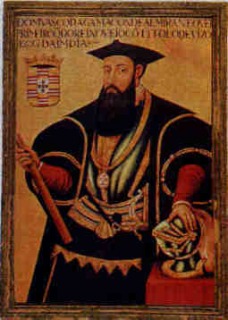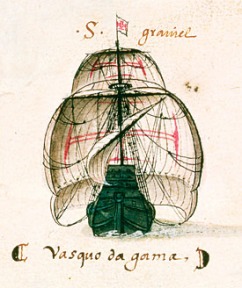A Great Navigator -Vasco da Gama

Portuguese sailor and navigator, ~1460 - 1524. He became the first to sail to India and the far East from Europe. Born around 1460 as the son of a prominent military, a fortress commander on the southwestern coast of Portugal. The Portuguese had at this time a very strong navy, and were also colonizing Africa and other continents. Since the beginning of the 15th century, Portugal had been trying to find a route around Africa, but had never succeeded. The reason for this was of course due to the Muslims of middle Asia monopolizing the trade by land with India. The idea was to find another way to trade directly with the far East.
Early Life
Vasco da Gama was born in a small seaport near Portugal. He participated in wars, that took place at Costel. He became a well trained sailor. He was King Manuel's (of Portugal) favorite sailor. When the King decided that Portugal had to find another route to India, he chose Vasco da
Gama to be the commander of the expedition to India.With this background, the King of Portugal, John II ordered a fleet of four ships to set sail for India in 1497. He made Vasco's father Estêvão da Gama leader of the expedition, but when Estêvão died shortly after, Vasco became the leader. The four ships left Lisbon and set course for Cape of Good Hope which had been discovered a couple of years earlier. After 10 months of sailing, da Gama's expeditions had rounded the Cape and had reached what today is Kenya. After picking up a pilot there - possibly the famous Arabic navigator Ahmed Ibn Majid - who could lead them to India, they finally reached Calicut (now Kolkata former Calcutta* now Kozhikode in Kerala) on May 20, 1498.
The arrival to Calicut didn't go smooth since the Muslim merchants protested the Portuguese presence, and the goods that da Gama had brought as gifts and for trade weren't in high demand in India. After an eventful trip back, where many of the sailors died from scurvy, they reached Portugal in late summer 1499. The next expedition for Vasco to India set sail in 1502, and has as a goal to break the Muslim resistance in India, and also to revenge the death of Portuguese officials left behind in India by a second expedition. A large fleet, some 20 ships, reached Goa in summer 1502. da Gama then went to bombard and massacre Muslims and Hindus in Calicut in order to subdue the ruler (Zamorin) of Calicut, but to no avail. Instead they want back to Portugal. However, the Muslim resistance was now broken. Thanks partly to Vasco, Portugal now had a small enclave in Goa, and also almost had monopoly on the trade with India. In 1524 Vasco da Gama became viceroy of India, and arrived there later the same year.
Accomplishments
Ten years after Bartholomew Diaz sailed his ship around the southern tip of Africa, da Gama sailed his four ships around the Cape of Good Hope to reach India. Once he got around the southern tip of Africa he was in uncharted territory, at least for the Portuguese. He needed to find a navigator to show him the way to India. As he traveled up the coast looking for a navigator, he did very cruel things to many people.. He tortured natives by using the drops. The drops were made out of boiling water and pitch. Even with the drops, no one would help him. Finally he kidnapped a sheik's servant, the sheik gave him a navigator in return for the servant's life. When he arrived in Calicut he was greeted by cheering crowds who carried him around in a sedan chair. After the celebration, da Gama gave the king gifts. The king was greatly insulted, because the gifts were not fit for a king. Da Gama was thrown out of the Calicut. When he was walking back to his ship, people lined the streets and chanted "Portugal, Portugal" and spat on the ground. He left Calicut and returned to Portugal. Da Gama had finally found a sea route to Asia, introducing the new way for explorers in the future.Da Gama came back to Calicut in 1502 with twenty ships. He was angry at how he had been treated. He attacked and burned a ship with three-hundred eighty passengers coming back from a pilgrimage to the Muslims' holy city of Mecca. He stayed and watched the ship burn for four days. He then found and hung thirty-eight fishermen from the rigging of his ship. That was his way of telling the people of India to get ride of the Muslims that controlled the spice trade.
Later Life
The King of Portugal, in 1524, decided India wasn't being run properly. He decided to ask the 64 year old da Gama to be India's new viceroy. Even though da Gama was living in retirement with his wife and six sons, he agreed to do what the king had asked. He didn't have a chance to be the new viceroy for long. In 1524, on Christmas eve, da Gama died. He had only been the viceroy three months.
Vasco da Gama’s ship

Vasco da Gama’s ship, under full sail and with a following wind, was illustrated in the Libro das Armadas in 1497
